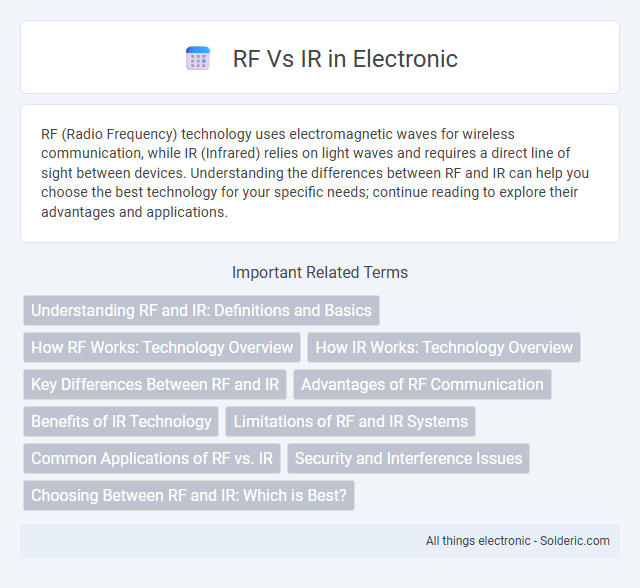RF (Radio Frequency) technology uses electromagnetic waves for wireless communication, while IR (Infrared) relies on light waves and requires a direct line of sight between devices. Understanding the differences between RF and IR can help you choose the best technology for your specific needs; continue reading to explore their advantages and applications.
Comparison Table
| Feature | RF (Radio Frequency) | IR (Infrared) |
|---|---|---|
| Signal Type | Radio waves (MHz to GHz ranges) | Infrared light waves (wavelength 700 nm to 1 mm) |
| Range | Up to several hundred meters | Typically under 10 meters |
| Line of Sight | No, can penetrate walls and obstacles | Yes, requires direct line of sight |
| Applications | WiFi, Bluetooth, RFID, remote controls | TV remotes, short-range communication, sensors |
| Interference | Susceptible to electromagnetic interference | Less susceptible but blocked by solid objects |
| Data Transfer Speed | High speeds, varies by technology (e.g., WiFi up to Gbps) | Generally lower, suitable for simple commands |
| Power Consumption | Moderate to high depending on device | Low power consumption |
| Security | Can be encrypted, vulnerable to interception | Less prone to interception without line of sight |
Understanding RF and IR: Definitions and Basics
Radio Frequency (RF) refers to electromagnetic waves used primarily for wireless communication, operating in the range of 3 kHz to 300 GHz. Infrared (IR) waves are a type of electromagnetic radiation with wavelengths between 700 nm and 1 mm, commonly utilized in remote controls and thermal imaging. Your understanding of these technologies hinges on recognizing that RF enables long-distance communication through radio waves, while IR relies on line-of-sight transmission using infrared light.
How RF Works: Technology Overview
RF technology transmits data through radio waves within specific frequency ranges, enabling wireless communication over varying distances. Your devices use RF signals to send and receive information via antennas, where modulated carrier waves carry encoded data efficiently through the air. This technology supports applications such as Bluetooth, Wi-Fi, and cordless phones, leveraging frequency bands tailored to optimize range and data throughput.
How IR Works: Technology Overview
Infrared (IR) technology operates by emitting infrared light waves, which are invisible to the human eye, to transmit data through line-of-sight communication. IR devices use photodiodes or phototransistors as receivers to detect the modulated infrared signals, converting light pulses into electrical signals for data interpretation. Common applications include remote controls, short-range communication systems, and motion detectors, where IR's reliance on direct light paths differentiates it from radio frequency (RF) technologies that use radio waves.
Key Differences Between RF and IR
RF (Radio Frequency) waves use electromagnetic signals for wireless communication over long distances, while IR (Infrared) relies on light waves for short-range line-of-sight transmissions. RF signals penetrate walls and obstacles, making them ideal for broadcasting and mobile devices, whereas IR requires direct alignment and is commonly used for remote controls and secure indoor communication. RF operates in radio spectrum bands like VHF and UHF, whereas IR functions within the infrared portion of the electromagnetic spectrum, typically between 700 nm and 1 mm wavelengths.
Advantages of RF Communication
RF communication offers superior range and penetration capabilities compared to IR, enabling reliable transmission through walls and obstacles in various environments. It supports multiple devices simultaneously without requiring direct line-of-sight, enhancing connectivity in complex setups like smart homes and industrial applications. The low power consumption and scalability of RF systems facilitate efficient long-term use and integration with emerging IoT technologies.
Benefits of IR Technology
Infrared (IR) technology offers precise line-of-sight communication with minimal interference from radio frequency (RF) noise, making it ideal for secure data transmission in controlled environments. IR devices consume less power than RF counterparts, enhancing battery life in portable electronics and remote controls. The unregulated IR spectrum eliminates the need for licensing, reducing costs and simplifying deployment in consumer and industrial applications.
Limitations of RF and IR Systems
RF systems face limitations such as signal interference from other electronic devices, lower data transmission speeds compared to IR, and security vulnerabilities due to signal penetration through walls. IR systems are limited by their need for a clear line of sight, sensitivity to ambient light interference, and shorter range for effective communication. Both technologies require careful consideration of environmental factors to optimize performance and reliability.
Common Applications of RF vs. IR
RF (Radio Frequency) technology is widely used for wireless communication, including Wi-Fi, Bluetooth, and cellular networks, enabling long-range data transmission and device connectivity. IR (Infrared) technology, common in remote controls and short-range data transfer, operates through line-of-sight signals typically used for home entertainment systems and some wireless peripherals. Your choice between RF and IR depends on the application requirements, such as range, line-of-sight constraints, and interference susceptibility.
Security and Interference Issues
RF (Radio Frequency) signals offer broader range and better penetration through obstacles, but are more susceptible to interference from other wireless devices, potentially impacting your security and connection stability. IR (Infrared) requires line-of-sight, which limits interference from external sources and enhances security by reducing the risk of signal eavesdropping or hacking. Choosing between RF and IR depends on your priority for secure, interference-free communication or broader, flexible coverage.
Choosing Between RF and IR: Which is Best?
Choosing between RF (Radio Frequency) and IR (Infrared) depends on your specific application needs, such as range, line-of-sight requirements, and interference susceptibility. RF signals offer broader coverage and better penetration through obstacles, making them ideal for wireless communication and remote controls in varied environments. IR requires direct line-of-sight but provides secure, interference-free connections suited for close-range devices like TV remotes.
RF vs IR Infographic

 solderic.com
solderic.com